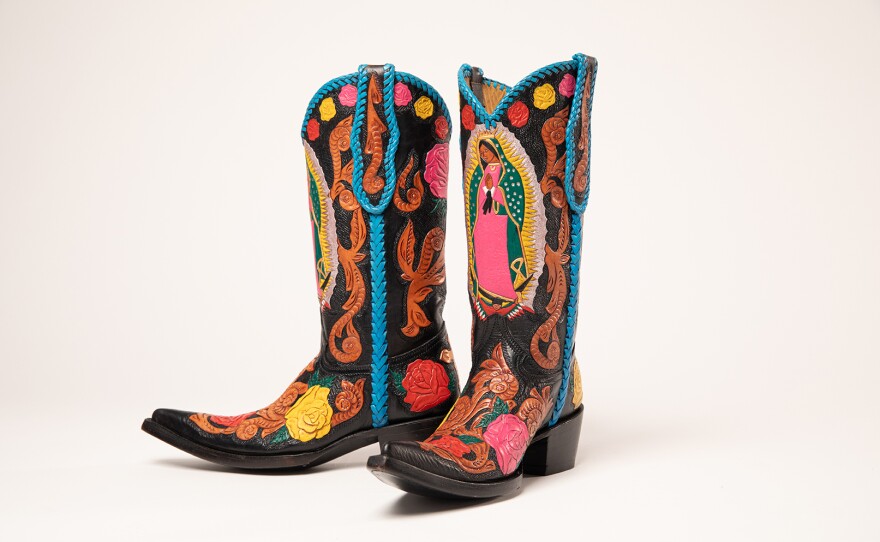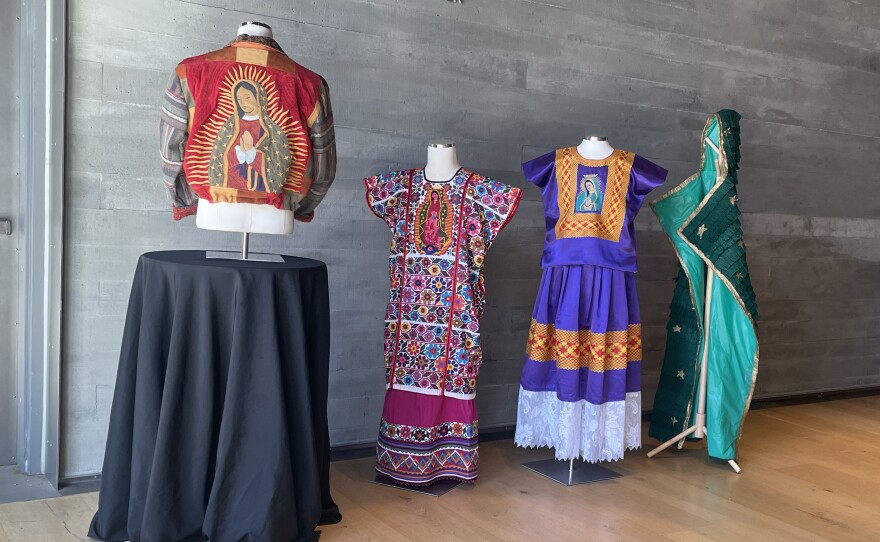Clothing, jewelry and accessories can be expressions of individual style and communal trends. They’re part of our daily lives — typically functional, yet often meaningful.
In a new exhibit at the Mingei, more than 70 garments and adornments share a unifying element: the icon of the Virgin of Guadalupe.
Curator Ariana Torres grew up surrounded by the image. She said the "Fashioning an Icon" exhibit not only looks at the Virgin's evolution and significance but specifically examines how she is represented in fashion and style.
"It's all about exploring the Virgin as a popular icon that has really grown past just being a religious symbol alone and really exploring her through the medium of textiles, garments and accessories," Torres said.

The Virgin of Guadalupe, known also as Our Lady of Guadalupe, La Virgen de Guadalupe or La Virgencita, is often depicted wearing a starry cape, head tilted down and framed by a vibrant sunburst. Torres said that the traditional Mexican icon of the Virgin Mary traces its origins to clothing.
"Her story really started through a garment — on a tilma of a man supposedly called Juan Diego," Torres said.
The story holds that Mary appeared to Juan Diego Cuauhtlatoatzin on a hillside, asking him to request that the bishop build a church there. When the bishop demanded proof, Diego returned to the site and found roses in bloom despite it being winter. He gathered the roses in his tilma, or cloak, and when he opened it before the bishop, an image of the Virgin Mary had appeared on the inside of the cloak.
"Because it started with this Indigenous voice on a garment, I think it’s really important to continue to explore her depiction through garments as well," Torres said.

Textiles and fashion items from the "Rosas y Revelaciones" collection of Mexican artists are shown alongside pieces by three local artists: Claudia Rodríguez-Biezunski, Diana Benavídez and Arianna Ytselle.
Artist and Sew Loka founder Rodríguez-Biezunski incorporates the icon into her upcycled fashion designs, including a reclaimed leather mosaic jacket featured in the exhibit.
"The image of the Virgencita means a lot of things to me. It is a symbol of hope, resilience. It reminds me of my grandma a lot. It's this comforting feeling, and every time I see her image, it really reminds me of that resilience that my grandma had, but also the warmth of someone that I can confide in — and manifest," Rodríguez-Biezunski said.
She also appreciates how the image has been embraced in contemporary culture.
"I feel like now we are claiming it in a different kind of identity — more of a modernized cultural identity," Rodríguez-Biezunski said. "You're seeing it a lot in Chicano culture, so you're seeing it more in low riders, nail art, a lot of tattoos. Traditionally they're like, 'Whoa, you don't, you know, that's not where you would see the Virgencita.' So it's really cool to be able to see her in a different way."

Local artist Benavídez has a piñata-inspired piece depicting the Virgin's cape, crafted in crepe paper and plastic.
"(Benavídez's) piece is called 'Even Guadalupe Needs a Break' and it's all about how the Virgin of Guadalupe at the end of a very long day of miracles and apparitions has taken off her cloak and placed it on a cloak stand," Torres said.
The piñata materials are something that Torres described as familiar and vital in the region.
"It's very recognizable and it's something that's tied to celebration and community and gatherings, and Diana uses it to speak to that cultural connection, but also to kind of turn it on its head and see how there's power in employing it in different ways and reclaiming it in different ways. I think it's a very feminist piece for that reason, because it's allowing this icon time to just be herself, and to essentially say, maybe not every moment has to be a productive moment and you can breathe and allow yourself that moment of rest."

Local photographer Ytselle also has a series of her photographs on display. Torres said Ytselle's photojournalism documents and celebrates the ways the Virgin of Guadalupe appears in the community, capturing her image in murals, fashion, tattoos and more.
The exhibit is on view at the Mingei Saturday through September 7. A related project, the Student Craft exhibit, features work by local high school students connected to the themes of "Fashioning an Icon."





